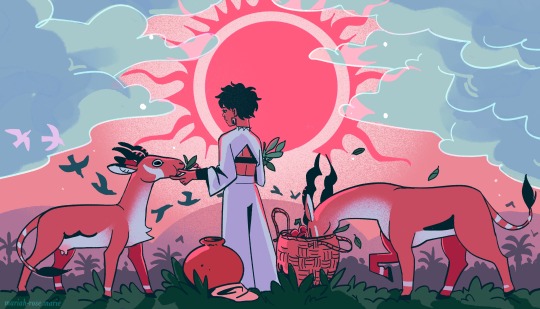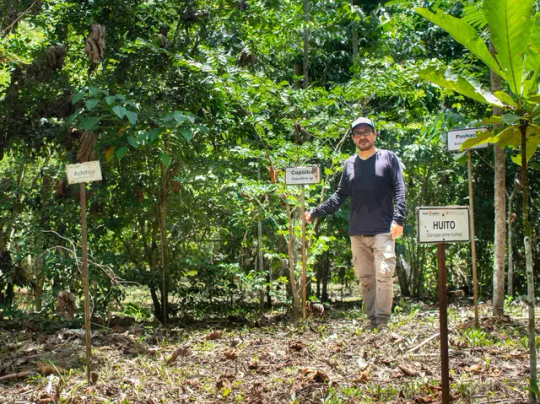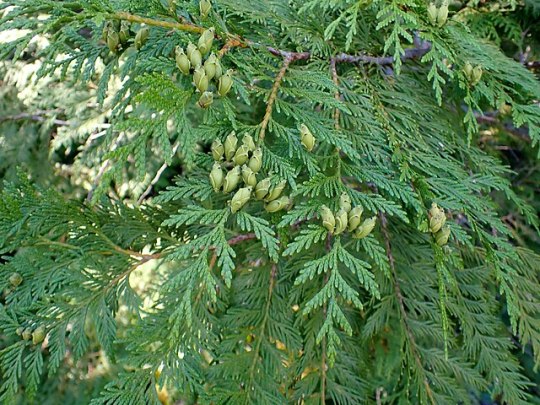#reforestation
Text
"A century of gradual reforestation across the American East and Southeast has kept the region cooler than it otherwise would have become, a new study shows.
The pioneering study of progress shows how the last 25 years of accelerated reforestation around the world might significantly pay off in the second half of the 21st century.
Using a variety of calculative methods and estimations based on satellite and temperature data from weather stations, the authors determined that forests in the eastern United States cool the land surface by 1.8 – 3.6°F annually compared to nearby grasslands and croplands, with the strongest effect seen in summer, when cooling amounts to 3.6 – 9°F.
The younger the forest, the more this cooling effect was detected, with forest trees between 20 and 40 years old offering the coolest temperatures underneath.
“The reforestation has been remarkable and we have shown this has translated into the surrounding air temperature,” Mallory Barnes, an environmental scientist at Indiana University who led the research, told The Guardian.
“Moving forward, we need to think about tree planting not just as a way to absorb carbon dioxide but also the cooling effects in adapting for climate change, to help cities be resilient against these very hot temperatures.”
The cooling of the land surface affected the air near ground level as well, with a stepwise reduction in heat linked to reductions in near-surface air temps.
“Analyses of historical land cover and air temperature trends showed that the cooling benefits of reforestation extend across the landscape,” the authors write. “Locations surrounded by reforestation were up to 1.8°F cooler than neighboring locations that did not undergo land cover change, and areas dominated by regrowing forests were associated with cooling temperature trends in much of the Eastern United States.”
By the 1930s, forest cover loss in the eastern states like the Carolinas and Mississippi had stopped, as the descendants of European settlers moved in greater and greater numbers into cities and marginal agricultural land was abandoned.
The Civilian Conservation Corps undertook large replanting efforts of forests that had been cleared, and this is believed to be what is causing the lower average temperatures observed in the study data.
However, the authors note that other causes, like more sophisticated crop irrigation and increases in airborne pollutants that block incoming sunlight, may have also contributed to the lowering of temperatures over time. They also note that tree planting might not always produce this effect, such as in the boreal zone where increases in trees are linked with increases in humidity that way raise average temperatures."
-via Good News Network, February 20, 2024
#trees#forests#reforestation#tree planting#global warming#climate change#climate crisis#american south#the south#eastern us#southern usa#conservation#meteorology#global temperature#conservation news#climate news#environment#hope#good news#hope posting#climate action#climate science#climate catastrophe#climate hope
13K notes
·
View notes
Text
The potential of newly created forests to draw down carbon is often overstated. They can be harmful to biodiversity. Above all, they are really damaging when used, as they often are, as avoidance offsets— “as an excuse to avoid cutting emissions,” Crowther said.
The popularity of planting new trees is a problem—at least partly—of Crowther’s own making. In 2019, his lab at ETH Zurich found that the Earth had room for an additional 1.2 trillion trees, which, the lab’s research suggested, could suck down as much as two-thirds of the carbon that humans have historically emitted into the atmosphere. “This highlights global tree restoration as our most effective climate change solution to date,” the study said. Crowther subsequently gave dozens of interviews to that effect.
This seemingly easy climate solution sparked a tree-planting craze by companies and leaders eager to burnish their green credentials without actually cutting their emissions, from Shell to Donald Trump. It also provoked a squall of criticism from scientists, who argued that the Crowther study had vastly overestimated the land suitable for forest restoration and the amount of carbon it could draw down. (The study authors later corrected the paper to say tree restoration was only “one of the most effective” solutions, and could suck down at most one-third of the atmospheric carbon, with large uncertainties.)
Crowther, who says his message was misinterpreted, put out a more nuanced paper last month, which shows that preserving existing forests can have a greater climate impact than planting trees. He then brought the results to COP28 to “kill greenwashing” of the kind that his previous study seemed to encourage—that is, using unreliable evidence on the benefits of planting trees as an excuse to keep on emitting carbon.
“Killing greenwashing doesn’t mean stop investing in nature,” he says. “It means doing it right. It means distributing wealth to the Indigenous populations and farmers and communities who are living with biodiversity.”
[...]
Crowther’s November study—with more than 200 scientists listed as coauthors—instead stresses the power of preserving intact woodlands. While restoring destroyed or fragmented forests would absorb a potential 87 gigatonnes of carbon, simply allowing existing forests to grow to maturity would absorb an additional 139 gigatonnes. These estimates exclude urban, farming, and grazing areas that may once have held forests but are unlikely to be given over to nature.
573 notes
·
View notes
Text
#good news#environmentalism#science#nature#environment#trees#reforestation#united states#u.s.#conservation#climate change#usa#climate crisis
330 notes
·
View notes
Text

new thing for new business cards: some lush future Africa, de colon1zed & self determined, where the great green wall has grown thick and steady & date palms & mango trees could maybe share canopies, adapting to the new weather patterns & all hope is not lost
(see more things from me via my newsletter, patreon, or bluesky)
#tumblr why must you destroy the quality#art#illustration#climatechange#afrofuturism#africa#greatgreenwall#reforestation#ecology#solarpunk#antelope#goats#farm#farmlife#painting#concept#herding#design#sahel#sahara#desert#restoration#wildlife#sunset#landscape#sun#star#redgiant#mariah-rose marie
89 notes
·
View notes
Text
Get Along
Collab with BBC Earth, Rewriting Extinction in association with Moondance Foundation
Ever felt… out of place? 🤨 Some trees feel the same way! Let’s plant native trees where they belong, so they can grow up to be strong, carbon-storing forests that work in perfect synergy! 🌳
Learn more about #OurGreenPlanet with BBC Earth and Rewriting Extinction.
Watch the animated version by Cut the Mustard here.

View On WordPress
#bbc#bbc earth#comics#comicsofinstagram#Comicstrip#future forest#moondance foundation#native trees#nature#our planet#plant more trees#reforestation#REWRITING EXTINCTION#save trees#tree#tree plantation#treehugger#trees#war and peas
829 notes
·
View notes
Note
Re: the idea that Palestinian Liberation is important to environmentalism
Generally speaking, settler colonizers kick out natives, who tend to have various rules about treating the environment healthily, and then exploit the land for all its worth and more. Anti-Zionists’ proverbial money is riding on the narrative that Israel is a settler colonial state and Palestinians are its dispossessed natives, so they just have to insist there’s an environmentalist angle on these grounds. It’s also ofc apart of the Anti-Zionist tendency to hijack every other cause under the sun.
I’ll admit I know next to nothing about the environmental policies and actions of Israel/Zionists and Palestinian Arabs in any part of history or the present. I’ll admit industrialization is a more Western trend and it is brought by those who spent time in the West, like Ashkenazi Jews. And maybe pre-Israel Palestine was less industrious/polluting. And I’m not a fan of how capitalist Israel has gotten, and there’s probably some level of pollution coming from that. But again, I’m ignorant to the details. I have heard Israel has made a lot of environmentalist progress with reforestation and such (tho I swear I heard something from anti-Zionists about Israel planting non-indigenous trees like colonizers have historically done but this could be BS) and I’ve heard of organizations that focus on environmentalism and diplomacy together (Avodah I think it’s called).
But here’s a point I really want to make: The idea that Palestine taking all of Israel’s land is all about framing the Palestinian as the Noble Savage. It’s another fantasy made by activists with white guilt and without an understanding of Palestinians as a people who may or may not do good things for the environment in likely equal measure. They’re not nature shamans.
Good timing - I just got another ask also requesting "that post myth busting the idea that Israelis grew a pine tree or something that caused forest fires and desertification."
So read this and this and this. Might as well read this and this too.
The entire Middle East has been heavily deforested by various colonial empires as well as being hard-hit by war. Israel has restored itself much better than its neighbors but it certainly doesn't have a perfect record; draining the malarial swamps in the 1940s devastated the indigenous painted frog so badly it was thought extinct for over 50 years. They are certainly industrialized / capitalist, but no worse than anybody else.
When "critics" try to call reforestation bad, they have totally lost the plot; just another example of what it means to be "Progressive Except Palestine."
See the tags for more on Israeli ecosystems :)
#israeli wildlife#wildlife of israel#forests#israel#palestine#antisemitism#middle east#reforestation#jumblr
71 notes
·
View notes
Text
youtube
Permaculture Instructor Andrew Millison visits the largest reforestation project in the world in the Southern Indian States of Tamil Nadu and Karnataka with the Isha Foundation, founded by Sadhguru. Andrew spent 5 days traveling around the Cauvery River watershed looking at the work of the Isha Foundations' Cauvery Calling project, touring farms, nurseries, temples, and talking with Isha's field agents. Andrew then went to Isha's ashram in Tennessee and was able to directly question Sadhguru about the project.
Check out Isha Foundation's Save Soil and its on-ground large-scale implementation Cauvery Calling represented at COP 28, Dubai
https://consciousplanet.org/en/save-s...
Isha Foundation's Cauvery Calling Project:
https://www.ishaoutreach.org/en/cauve...
Thanks to Shubo Biwas and Green Good Labs for the technical collaboration:
https://www.greengoodlabs.com/
Andrew Millison’s links:
https://www.andrewmillison.com/
https://permaculturedesign.oregonstat...
JOIN THIS CHANNEL to get access to uncut video content and live Q & A sessions:
/ @amillison
SIGN UP FOR MY FREE NEWSLETTER:
https://share.hsforms.com/1X79TznHYRC...
#Andrew Millison#solarpunk#permaculture#india#water#reforestation#Tamil Nadu#Karnataka#Isha Foundation#Sadhguru#cauvery river#Cauvery#watershed#Cauvery Calling project#ashram#Tennessee#trees#planting trees#planting#tree#drought#Youtube
37 notes
·
View notes
Text
youtube
Does planting trees actually cool the planet? - Lesson by Carolyn Beans, directed by Ivana Bošnjak, Thomas Johnson Volda.
#video#ted ed#animation#ivana bošnjak#ivana bosnjak#thomas johnson volda#trees#carolyn beans#alexandra panzer#gerta xhelo#stephen larosa#sazia afrin#alex rosenthal#shannon odell#charles wallace#carbon offset#greenwashing#reforestation#afforestation#Youtube
23 notes
·
View notes
Link
“How do you supercharge vegetation growth for a reforestation project? Bring in the microorganisms.
That’s the finding from a new study, which shows that incorporating a microbial community of fungi, bacteria, algae and archaea into ecosystem restoration can accelerate plant biomass production by 64% on average.
Researchers say this application holds plenty of promise for restoration work in Southeast Asia, where large swaths of once-forested landscapes have been degraded for large-scale agriculture.
Soil microbiome like fungi carry out a critical task known as soil transplant, moving soil and associated microbial communities from one location to another. But they’re often overlooked in conservation and restoration efforts, said study lead author Colin Averill, a senior microbial and ecosystem scientist at the Swiss Federal Institute of Technology, or ETH Zürich.
“When we think to plant a tree, we never think to ‘plant’ the microbiome, right? But what if we did?” Averill told Mongabay.
To find out how big a role the microbiome plays in ecosystem restoration, Averill and colleagues from ETH Zürich, the Czech Academy of Sciences in Prague and Vrije Universiteit in the Netherlands pored over the date from 27 restoration projects that incorporated microbial restoration.
Their study, published in the journal Nature Microbiology, found that across all the restoration works, there was an average of 64% increase of plant growth. In one case, plant growth was stimulated by 700%.
The study shows that incorporating the microbiome in managed landscapes like farmland and forestry concessions has the greatest potential. This is because managed landscapes account for the majority of human land use, covering half of the global habitable land surface.
But by introducing microbial communities, these agricultural and forestry plantations [and monocultures] that are currently devoid of biodiversity could become reservoirs of it, Averill said.
To increase biodiversity and enrich these managed landscapes, it’s important to avoid using single species or very low-diversity, non-native soil organisms at a large scale, Averill said.
The study notes an increasing number of microbial inoculant companies advocating for just this on the argument that it could improve crop yields. But the mass application of a single species could lead to a loss of genetic and ecological diversity, and is unlikely to account for ecosystem-specific requirements, the study says.
It instead recommends using locally sourced, native and biodiverse communities of soil organisms as these can promote biodiversity in managed landscapes without limiting crop yields.” -via Mongabay, 1/5/23
#mongabay#mongabay environmental news#environmental news#conservation news#fungi#microbiome#monoculture#agriculture#reforestation#forest restoration#southeast asia#good news#hope#microorganisms
177 notes
·
View notes
Text
Solarpunk Sunday Suggestion:
Plant a tree 🌳
#solarpunk#hopepunk#environmentalism#cottagepunk#social justice#community#optimism#bright future#climate justice#tidalpunk#lunarpunk#turbinepunk#afforestation#reforestation#trees#solarpunksundays
19 notes
·
View notes
Link
Nowadays, most wood is harvested by killing trees. Before the Industrial Revolution, a lot of wood was harvested from living trees, which were coppiced. The principle of coppicing is based on the natural ability of many broad-leaved species to regrow from damaged stems or roots – damage caused by fire, wind, snow, animals, pathogens, or (on slopes) falling rocks. Coppice management involves the cutting down of trees close to ground level, after which the base – called the “stool” – develops several new shoots, resulting in a multi-stemmed tree.
[...]
Because of the short rotation cycles, a coppice forest was a very quick, regular and reliable supplier of firewood. Often, it was cut up into a number of equal compartments that corresponded to the number of years in the planned rotation. For example, if the shoots were harvested every three years, the forest was divided into three parts, and one of these was coppiced each year. Short rotation cycles also meant that it took only a few years before the carbon released by the burning of the wood was compensated by the carbon that was absorbed by new growth, making a coppice forest truly carbon neutral. In very short rotation cycles, new growth could even be ready for harvest by the time the old growth wood had dried enough to be burned.
#sustainability#environmentalism#green energy#renewable energy#degrowth#solarpunk#low tech#agroforestry#forestry#deforestation#reforestation
142 notes
·
View notes
Text
"Sunlight dapples the once-denuded forest floor as saplings spread their branches and leaves overhead, slowly forming a lush canopy.
Beside each young tree, a sign notes its species. Lupuna, says one, the colloquial Peruvian term, and below that its scientific name, Ceiba pentandra — in other words, a kapok tree, known for its cotton-like fibers. Huito, says another sign, or Geinpa americana, which produces edible gray berries.
Each sapling is distinct, a reflection of the Amazon's stunning biodiversity, with so many different species that you might go acres without finding a repeat.
Yet this young forest did not spring up naturally. It has been carefully recreated by humans in an area that was, until just three years ago, a heavily contaminated moonscape.
This land was stripped of its dense vegetation by miners scouring the subsoil for tiny specks of gold, using mercury to separate the gold from the sediment. Many thought that a healthy forest would never thrive in impoverished, mercury-laden topsoil and that the piles of sandy tailings, the residue from the gold mining effort, and the pools of wastewater were irremediable...
"It feels good to see the forest grow back," says Pedro Ynfantes, 66, the miner whose legal mining concession of 1,110 acres includes this 10-acre patch of land where this young forest is located. "We don't want to deforest. When we had the opportunity to let the forest grow back, we took it. It's much better this way."
The opportunity he refers to came via U.S. nonprofit Pure Earth, which works with communities across the Global Southto remediate environmental problems left behind by mining, much of it illegal. Their biggest targets are mercury and lead contamination...
Security forces have launched anti-mining operations down the years, even blowing up the miners' equipment deep in the jungle. But most local politicians, including Madre de Dios' members of Peru's national congress, broadly support the miners, who are a powerful constituency in the relatively sparsely populated jungle region.
Restoring the forest

Pictured: France Cabanillas works for the nonprofit group Pure Earth, which is spearheading an effort to plant saplings in areas of the Peruvian Amazon that were devastated by illegal gold mining.
Now there's an effort to address the damage. Initially working with the region's legal miners, most of whom were here before the 2009 gold rush kicked off, the nonprofit group Pure Earth is using this patch of Ynfantes' land as a pilot project to show how the rainforest can be regenerated after the last traces of gold have been plucked from the soil.
It took a sustained outreach effort. Many miners are wary of or even downright hostile to foreign NGOs, which have repeatedly called for gold mining to be banned or severely curbed in the Peruvian Amazon — steps they say would cost them their livelihood.
"I am feeling optimistic," says France Cabanillas, Pure Earth's local coordinator, who has been appealing to the frustration of many miners at the heavy toll they have taken on the jungle and their desire to minimize their environmental footprint for the next generation.
"We still have a lot to do but this pilot is going well. Down the years, the miners have been getting a lot of stick but not much carrot when it comes to their environmental impacts," says Cabanillas. "We are offering them a carrot, allowing them to remediate their own impacts. Many of the miners do not want to be destroying the rainforest."
Before the miners plant the carefully-selected mix of tree species, they had to prepare the earth. Most of the topsoil had been washed away by the miners' heavy use of hoses.
That preparation involved adding biochar (burnt organic material) and even molasses, which contain fixed carbon and minerals, along with various other nutrients. The miners also had to dig tiny moats around the saplings to prevent all of this new planting from being washed away. Now, after three years, the forest is visibly coming back.
The rejuvenated rainforest also mitigates the impact of the mercury used by many of the illegal miners.
Research done by Pure Earth shows that the barren, sandy soil emits mercury. But in a rainforest, the ecosystem actually absorbs some of the metal, boosting public health."
-via NPR, April 2, 2024
#mining#illegal miners#gold#gold mining#peru#rainforest#ecosystem#mercury#environment#pollution#remediation#reforestation#good news#hope
336 notes
·
View notes
Link
Every year, “millions of dollars” are spent on reforesting landscapes, according to Lalisa Duguma of World Agroforestry, an international research agency in Nairobi, Kenya. Yet “there are few success stories.” Typically only a minority of seedlings survive, he says, because the wrong trees are planted in the wrong places, and many are left untended, in part because ownership and management of trees is not handed over to local communities.
Such failures often go unnoticed, believes Duguma, because performance indicators measure planting rates not survival rates, and long-term oversight is minimal because projects typically last three years or less. The result is “phantom forests.”
[...]
Too often, argues Duguma, tree planting is “greenwashing” aimed at grabbing headlines and promoting an image of governments or corporations as environmentally friendly. Tiina Vahanen, deputy director of forestry at the UN’s Food and Agriculture Organization, noted recently that many projects end up being little more than “promotional events, with no follow-up action.”
Cynical PR is one thing, but phantom forests are also increasingly sabotaging efforts to rein in climate change. This happens when planters claim the presumed take-up of carbon by growing forests as carbon credits. If certified by reputable bodies, these credits can count toward governments meeting their national emissions targets or be sold to industrial polluters to offset their emissions. Many corporations plan to use their purchase of carbon credits as a means of fulfilling promises to attain “net-zero” emissions. So the stakes are rising.
4K notes
·
View notes
Text

#good news#environmentalism#science#environment#africa#trees#tree planting#reforestation#trees for future
146 notes
·
View notes
Text
The most amazing thing in nature for me is the hope/rebirth When you think that everything is lost, a seed can save an entire species, a dry tree that looks dead will grow beautier when it rains. The smalls sprouts growing in a cutted tree, a river backing to live after the winter or dry season, an extinct species reappering again after decades, how corals grow in a sunken ship, flowers groing through the smalls cracks in cement, trees taking back abandoned buildings, nature taking back everything. How a corpse will feed new life, how a forest grows backs after a burn, how the sun always rises agains, how one or more couples of some animals can repopulate an entire forest and how live always gets a way to go on.
#rebirth#forestcore#trees#nature#naturecore#hopecore#hopepunk#solarpunk#random toughts#Cotidiano Tedtalks#ecopunk#reforestation#hopefully#kindness#i love this#self growth#anti consumerism#we will grow through the ashes#i love flowers
17 notes
·
View notes
Text

Hey, this is for my west-of-the-mountains PNW folks!
As they have for the last several years The Carbon Capture Foundation (TCCF) is offering free bare root native tree seedlings this fall for folks wanting to increase tree cover on their property. Primarily four species will be provided: Douglas fir, western red cedar, black cottonwood, and red alder. However if other species are needed, that may be possible by special arrangement. Generally the limit per household is 240 seedlings per year, but this limit may be exceeded by arrangement with TCCF. Pickup will be in southwest Washington near Longview.
Tree recipients are responsible for making arrangements to plant their seedlings and maintaining them. WSU and OSU Extension Foresters are available to help with questions online, by phone and sometimes in person. Also materials on seedling planting, care and maintenance will be provided by TCCF when you pick up the seedlings.
The only limitations for receiving the free seedlings is that they cannot be used for commercial purposes, for replanting areas you have had logged, or for planting areas that you have to plant to keep your ground as forest land for tax purposes. For planting purposes these trees should generally be planted about 12 feet apart. And cedars are best planted in areas that tend to be wet or close to wet areas. With our current drought conditions cedars are struggling to survive in dry areas that they formerly did well in.
Interested? Contact TCCF president Norm Dick at (360) 751-3142, or norm(at)thecarboncapturefoundation(dot)org
#reforestation#trees#climate change#carbon capture#environment#conservation#PNW#Pacific Northwest#ecology#nature#Washington#Oregon#restoration ecology#habitat restoration
44 notes
·
View notes